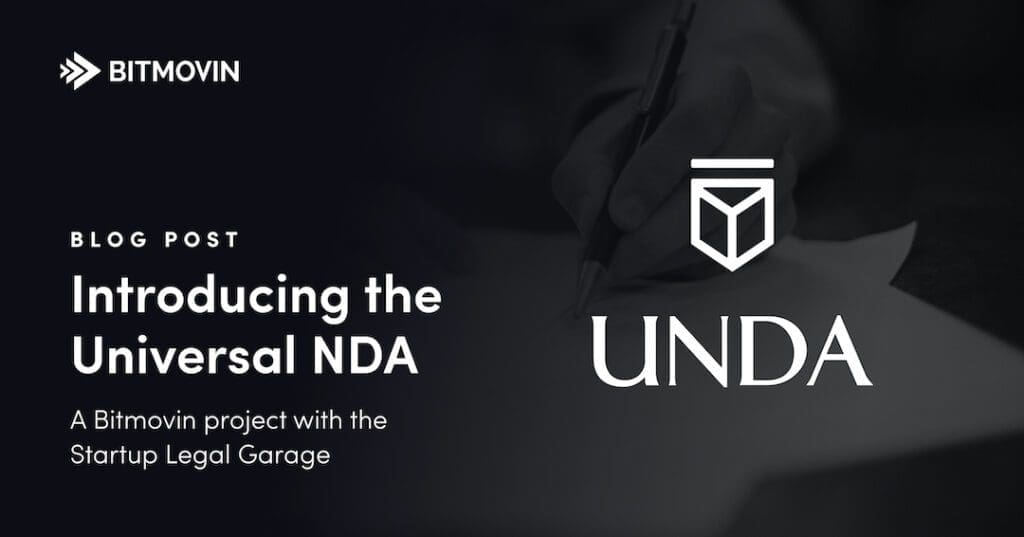NDAs for Everyone
“I suffered through the LSAT, endured three grueling, sleepless years in law school, and studied countless hours to sit for the bar exam just so that I could review and negotiate innumerable, mundane, and mind-numbingly dull non-disclosure agreements (NDA) until the wee small hours of the morning,” said no lawyer ever.
NDAs are a necessary part of business formation. However, we have long felt negotiating NDAs to be an unnecessary use of time. All (good) NDAs say basically the same thing and one shouldn’t bother with bad NDAs in the first place. Yet even good NDAs have to be read and reviewed. Even if it takes a qualified, senior lawyer only 15 minutes to review an NDA and come to a recommendation, this work can quickly come to total hundreds of lawyer-hours per year in a business at or achieving scale.
Given this, we have continued to wonder if there is a better way. To this end, Bitimovin undertook a project with the Startup Legal Garage at UC Hastings College of the Law. The project was led by two students in the program, Jami Fogelhut and Armin Givechi. The objective of the project was to create an NDA for routine commercial transactions that could be widely adopted in order to reduce the need to negotiate NDAs, or perhaps even read them, for routine commercial transactions. And, when negotiations are required for clauses in the NDA, it would be a paint-by-numbers approach.
Reducing Redlines
The project team began the process of creating a “Universal NDA” by reviewing hundreds of NDAs to determine the most salient and common clauses therein. They then interviewed nearly two dozen general counsels of tech companies, ranging from small startups to multinational corporations in the Bay Area. The result was a clear, standardized NDA in which clauses are represented by a word or phrase. The approach is not dissimilar to the Creative Commons seven essential licenses. Creative Commons licenses let creators distribute their content easily. Normally, copyright licenses are complex instruments. By simplifying these complex licenses into their finest essence, they can cover the most common use cases such as whether to limit the ability to reuse or remix the copyrighted work.
We then open-sourced all of the text of the NDA and all materials related to it, placing them in this Github repo. We also prepared a version for the Ironclad workflow library. The text of the NDA is distributed with an extremely permissive license. Anyone can use, copy, reproduce, perform, display, and modify the text of the NDA, including for commercial purposes. The license requires no back contributions, but if you have drafted something really good, we strongly encourage you to commit it back to the repo.
The Universal NDA
And thus, the Universal NDA (uNDA) was formed, based on 13 clauses and their permutations. We call these the “Included Clauses”. If appropriately disclosed, the Included Clauses may be coupled with optional fill in the blanks that provide additional details for specificity. The permutation of the clause addresses the concern that a particular definition is too broad or to provide firmer guard rails. – If the NDA contains clauses beyond those contained in the uNDA the drafter is required to expressly disclose that the agreement contains “Other Clauses”. We had intended to create icons to represent each of the 13 Included Clauses and for the Other Clauses, similar to those in use by Creative Commons licenses. However, given the academic limitations of the project, we were not able to do so. If you are artistically inclined and would like to contribute to the project, we invite you to make a submission here: https://github.com/bitmovin/unda.
For any NDA to be compliant with the uNDA requires that the drafter abides by a simple rule: the signatories will not assert that the text of the NDA, even if modified, is materially different from a reasonable interpretation of the text as contained in the repo on the day the NDA is executed. This will allow a body of law to coalesce around the NDA, giving the certainty that comes with it.
For these reasons, Bitmovin is adopting the uNDA for its routine commercial transactions and will happily (and quickly) agree to a uNDA sent to us by any prospective customer or vendor.
The Future of Negotiations
The version of the Universal NDA which Bitmovin has in its contract management system will allow us to negotiate most terms via email forms, and lawyers are only necessary when human intervention is required when special terms are requested. For SaaS organizations like Bitmovin, the next potential leap would be the creation of a conventional agreement with generally-accepted legal terms for indemnification, limitation of liability, warranties, etc. Product-specific commercial terms and license grants could be modularized and plugged into the standard agreement.
One last thing, this is not legal advice in any way.
Video technology guides and articles
- Back to Basics: Guide to the HTML5 Video Tag
- What is a VoD Platform? A comprehensive guide to Video on Demand (VOD)
- Video Technology [2022]: Top 5 video technology trends
- HEVC vs VP9: Modern codecs comparison
- What is the AV1 Codec?
- Video Compression: Encoding Definition and Adaptive Bitrate
- What is adaptive bitrate streaming
- MP4 vs MKV: Battle of the Video Formats
- AVOD vs SVOD; the “fall” of SVOD and Rise of AVOD & TVOD (Video Tech Trends)
- MPEG-DASH (Dynamic Adaptive Streaming over HTTP)
- Container Formats: The 4 most common container formats and why they matter to you.
- Quality of Experience (QoE) in Video Technology [2022 Guide]




